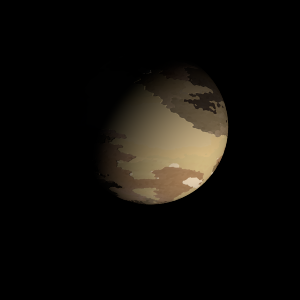|
|
Space Astro
|
Info for exoplanet "Hyojida"
| Scientific (actual) data |
|---|
| Name | L 98-59 e |
| Planet status | Confirmed |
| Mass sini | 0.00963 |
| Orbital period | 12.796 |
| Semi major axis | 0.0717 |
| Orbit eccentricity | 0.128 |
| Discovered | 2021 |
| Updated | 2021-08-06 |
| Omega | 165 |
| Tperi | 2458440 |
| K | 2 |
| Temperature (kelvin) | 432 |
| Publication | Published in a refereed paper |
| Detection type | Radial Velocity |
| Mass measurement type | Radial Velocity |
| Alternate names | TOI-175 e |
| Star name | L 98-59 |
| Right ascension | 124.53° |
| Declination | -68.31° |
| Mag v | 11.7 |
| Star distance | 10.623 |
| Star metallicity | -0.46 |
| Star mass | 0.32 |
| Star radius | 0.291 |
| Star sp type | M3V |
| Star age | 5.4 |
| Star temperature | 3415 |
| Star alternate names | TOI-175 |
| Wikipedia article | L 98-59 e |
Back
| |
| Fictional info (?) |
|---|
| Suggested name | Hyojida |
| Planet type | Terrestrial |
| It has the longest rotation period (445 days) of any planet in its solar system and rotates in the opposite direction to most other planets.
Having almost no atmosphere to retain heat, it has surface temperatures that vary diurnally more than on any other planet in its solar system, ranging from 100°K (-173°C) at night to 770°K (497°C) during the day across the equatorial regions. |
| Atmosphere | Helium | 99% |
| Carbon dioxide | 0.18% |
| Atmospheric pressure | 0.012 bar |
 |
| No known satellites |
| Google search for Hyojida |
|
Website by Joachim Michaelis
|
|
|
|